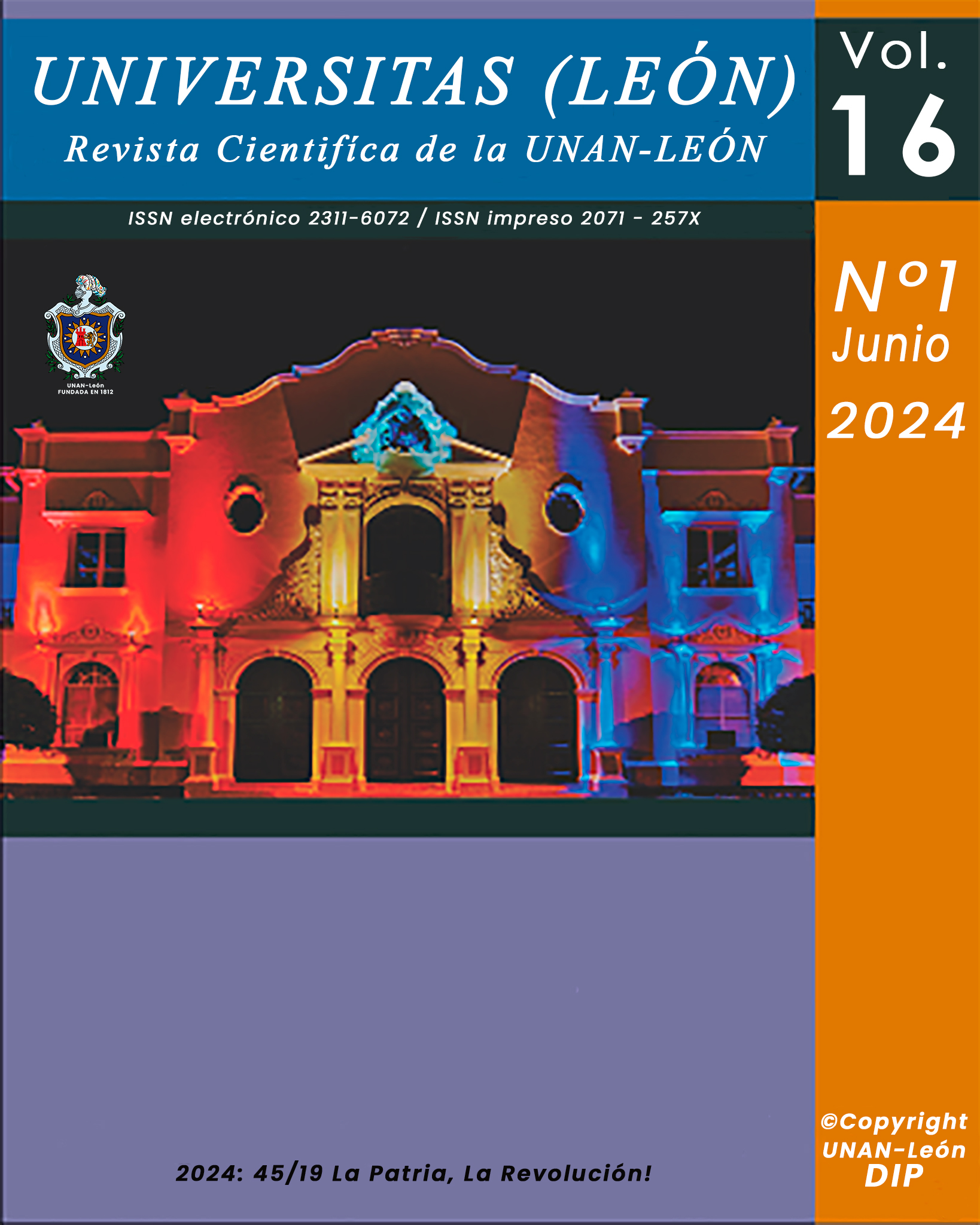Educational strategy to strengthen learning in the geoschools of the Río Coco UNESCO World Geopark
DOI:
https://doi.org/10.5377/universitas.v16i1.19035Keywords:
educational strategy, learning, geoschools, Río Coco Geopark, UNESCOAbstract
In the context of the protection and dissemination of the geopatrimony of the Río Coco Geopark, the results of the implementation of an educational strategy are presented, with the aim of strengthening learning in students from five geo-schools in the territories of Somoto, San Lucas, Las Sabanas, San José de Cusmapa, and Totogalpa, in the department of Madriz. The methodology that guided the study was a qualitative paradigm and its approach with a Participatory Action Research focus, where all stakeholders were part of the process. The sample was selected through the convenience method, involving teachers, students, and community leaders from the prioritized geosites. The main results are evidenced in the proposal for the development of a «Geopark Didactic Handboo» that includes the educational and innovative strategies developed by teachers for student learning. With this initiative, UNESCO evaluators for the year 2023 rated the intervention process of UNAN León-CUR Somoto through the project funded by competitive funds from the National Council of Universities (CNU) as «Excellent.» The consolidation of five geo-schools and proposal of naming in the territory to address key elements such as promotion of education, conservation, and sustainable development in the region marks a significant milestone in the protection of local geopatrimony. Lastly, the leagues of knowledge allowed to assess the level of knowledge acquired by students about the empowerment of the Geopark.
Downloads
271
References
Aguilar, R. (2004). La guía didáctica, un material educativo para promover el aprendizaje autónomo. Universidad Técnica Particularde Lojan.
Alcaldía Somoto. (2019). Informe de procesos de gestión de la creación del Geoparque Río Coco. Somoto.
Araya-Crisóstomo, Sandra, & Urrutia, Mabel. (2022). Uso de metodologías participativas en prácticas pedagógicas del sistemaescolar. Pensamiento educativo, 59(2), 1-16.https://dx.doi.org/10.7764/pel.59.2.2022.9
Díaz Barriga, F. y Hernández Rojas, G. (1998). Estrategias docentes para un aprendizaje significativo.Edit. Mc Graw. México.
Ghiso, A. (1999). Acercamientos: el taller en procesos de investigación interactivos. Estudios sobre las Culturas contemporáneas, 5(9), 141-153.
Hernandez Sampieri, R., Fernández Collado, C., & Baptista Lucio, P. (1997). Metodología de la investigación. México: Mc Graw Hill.
INTUR . (7 de Julio de 2020). Nicaragua integra Red Mundial de Geoparques con sitios de Madriz. Obtenido de https://www.intur.gob.ni/2020/07/07/nicaragua-integra-red-mundial-de-geoparquescon-sitio-de-madriz/
MINED Nicaragua. (2009). Diseño curricular del subsistema de la educación básica y media nicaragüense. Obtenido de https://www.mined.gob.ni/biblioteca/wp-content/uploads/2018/08/DisenoCurricular_subsistema.pdf
Monereo. C. (Coord.); Castelló, M; Clariana, M; Palma, M y L. Pérez, M (1999). Estrategias de enseñanza y aprendizaje. Formación delprofesorado y aplicación en la escuela. Barcelona: Graó.
Muñoz y Rubí, A. C. (2020). Geoparque: Guía Docente Educación Primaria. Universitaria UNAN-Managua.
Schilling, M. E., Contreras, A. M., Farías, C., Tascón, G., & Partarrieu, D. (2022). Geoparque Mundial UNESCO Kütralkura: Laboratorionatural para la educación sobre Geoparque Mundial UNESCO. Kütralkura: En IX Foro Internacional de Peligros Volcánicos - IX FIPVO
UNESCO. (2017). Los Geoparques mundiales de la UNESCO: celebrando el patrimonio de la tierra, sosteniendo las comunidades locales.Obtenido de https://unesdoc.unesco.org/ark:/48223/43650_spapf00002
UNESCO.(2018). Geoparques, turismo sostenible y desarrollo local. México: UNESCO México.
UNESCO. (2020). Río Coco, el primer Geoparque Mundial de la UNESCO en Centroamérica. Obtenido de https://www.unesco.
org/es/articles/rio-coco-el-primer-geoparque-mundial-de-launesco-en-centroamerica.
UNESCO México. (2021). geoparques, turismo sostenible y desarrollo local. Méxco DF: Organización de las Naciones Unidas para
la Educación.
UNESCO. (2023). Los Geoparques Mundiales de la UNESCO. Obtenido de https://www.unesco.org/es/iggp/geoparks/about
UNESCO. (2018). Geoparques, turismo sostenible y desarrollo local. México: UNESCO México.
UNESCO. (2020). Río Coco, el primer Geoparque Mundial de la UNESCO en Centroamérica. Obtenido dehttps://www.unesco.org /es/articles/rio-coco-el-primer-geoparque-mundial-de-la-unescoen-centroamerica.
UNESCO México. (2021). Geoparques, turismo sostenible y desarrollo local. Méxco DF: Organización de las Naciones Unidas para
la Educación.
UNESCO. (2023). Los Geoparques mundiales de la UNESCO. Obtenido de https://www.unesco.org/es/iggp/geoparks/about
Downloads
Published
How to Cite
Issue
Section
License
Copyright (c) 2024 National Autonomous University of Nicaragua, León.

This work is licensed under a Creative Commons Attribution-NonCommercial-ShareAlike 4.0 International License.
Copyright © 2025 Universitas (León), Revista Cientifíca de la UNAN-León. Academic Direction. Research Department. Publication and Scientific Event Unit.






